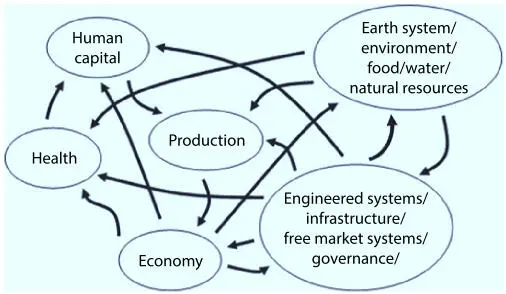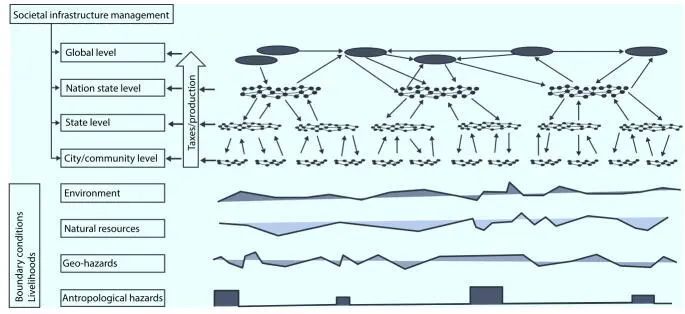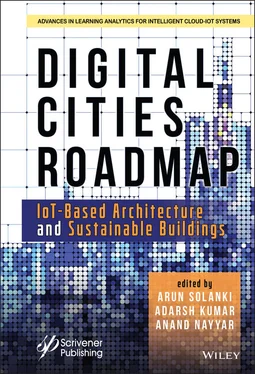Resilience provides a holistic solution to risk handling catastrophic incidents, as well as environmental problems, through structures that allow new generations the same opportunities to prosper. Communities will move for a more socially and economically equitable and prosperous environment by resolving skill differences and essential threats through a systemic integrated and systematic strategy [29 –35]. Approaches include: introduction into City planning and network projects with adaptability, resilience and regeneration, utilizing a framework methodology that tackles multi-scale connections and dependency and methodologies that resolve the complexity of the potential severity of hazards (Table 1.2).
Table 1.2Planning for community resilience [55].
| Planning steps |
Key activities |
| 1. Form a collaborative Planning Team |
Identify resilience leader for the communityIdentify team members, and their roles and responsibilitiesIdentify key public and private stakeholders for all phases of planning and implementation |
| 2. Understand the situation |
Social DimensionsIdentify and characterize functions and dependencies of social institutions, including business, industry, and financial systems, based on individual/social needs met by these institutions and social vulnerabilitiesIdentify how social functions are supported by the built environmentIdentify key contacts and representatives for evaluation, coordination, and decision nuking activitiesBuilt Environment➢ Identify and characterize buildings and infrastructure systems, including condition, location, and dependencies between and among systems➢ Identify key contacts/ representatives for evaluation, coordination, and decision-making activities➢ Identify existing plans to be coordinated with the resilience planLink social functions to the supporting built environmentDefine building clusters andsupporting built environment supporting infrastructure |
| 3. Determine goals and objectives |
Establish long-term community goalsEstablish desired recovery performance goals for the built environment at the comma level based on social needs, and dependencies and cascading effects between systemsDefine community hazards and levelsDetermine anticipated performance during and after a hazards event to support social functionsSummarize the results |
| 4. Plan development |
Evaluate gaps between the desired and anticipated performance of the built environment to improve community resilience and summarize resultsIdentify solutions to address gaps including both administrative and construction optionsPrioritize solutions and develop an implementation strategy |
| 5. Plan preparation, review and approval |
Document the community plan and implementation strategyObtain feedback and approval Mon stakeholders and communityFinalize and approve the planMon stakeholders and community |
| 6. Plan implementation and maintenance |
Execute approved administrative and construction solutionsEvaluate and update on a periodic basisModify short or long-term implementation strategy to achieve performance goals as needed |
1.5 Sustainability and Resilience of Engineered System
The word “anthroposphere” has more and more been used by scientists to emphasize the impact of human existence in the new geological era. The accelerated demographic increase, technical advances and industrialization have reached a state in which the relations of human enterprises, the global environment of the world and the surroundings have a devastating effect on potential social changes at local level. The lack of natural capital, arable and inhabitable property, potable water and lifethreats in general, are increasingly impacting civilization-culminating in civil instability and migration. Human environmental emissions are widely accepted to adversely affect the earth’s geology and biosphere itself, thereby affecting the same living conditions which enable human civilization to be promoted in various ways, including global climate change. Regions and towns are not merely at danger, but are also a fact for millions. Environmental contamination, clean water and land, significant damage to the safety, well-being and livelihoods of current and future generations are a hazard. A global catastrophically danger must be taken seriously at all stages of society’s policy-making in the absence of sustainable social growth.
Earth structure and individual behavior on the functionalities of health organizations. It is therefore clear that the relation between sustainable growth and resilience is powerful and that the two concepts are essentially similar from two separate viewpoints, see also Figure 1.2.

Figure 1.2Societal principle of resilience and sustainability.
1.5.1. Resilience and Sustainable Development Framework for Decision-Making
A program delegate must be developed to encourage the creation of decision-making resources for the resiliency, healthy community and to promote the rating of decision-making options in line with the information required, compatible with priorities and goals and conforming to potential requirements. The following introduces a structure representation paradigm, which fits closely Faber et al. [58].
• Analysis system representation of hierarchical decisions
In order to help decisions about the management of processes, it is essential to create structure representations that regularly chart potential alternative options for decision-makers and the stakeholders involved in achieving their priorities. This assumes that the nature of the structures is decided by the policy makers, stakeholders and their choice, time-boundary and spatial limits, the functional features and functionality of the systems and their impact on system efficiency, and feasible and appropriate decision-making alternatives.
In other governance contexts, such as private organizations, or industrial practices, the overarching concept which underlies the hierarchical governance system seen in Figure 1.3 may be extended.
Theoretically, it is important for decisions to be rated in accordance with their anticipated worth (or benefit) in accordance with the Bavarian Decision Analytics and the axioms to be made in order to automate the design and/or the management of engineering systems subject to complexity and inadequate information in a normative decision sense.
The structure as outlined in Figure 1.4 incorporates not just threats in terms of potential negative value in various applicable indicators (e.g. negative in life, disruption to environmental values and financial losses) but also gains linked to decision-making options—the key goal of optimized structures—as opposed to more traditional risk-informed solutions to decision-making. The expansion supported the way Section 4 discusses durability and longevity as a framework for evaluation for stability outlined by Linkov et al. [59], thus accurately correcting typical risk modeling limitations. Specific decision alternatives to designed device architecture and management in accordance with the predicted utility benefit or any particular metrical requirements can be assessed and classified according to the device modeling paradigm as outlined in Figure 1.5.

Читать дальше



![Чарльз Диккенс - A Tale of Two Cities [С англо-русским словарем]](/books/26616/charlz-dikkens-a-tale-of-two-cities-s-anglo-thumb.webp)










